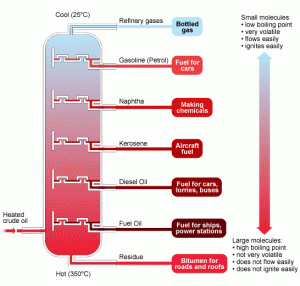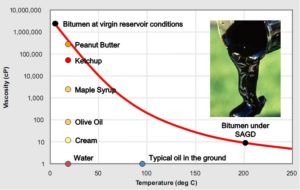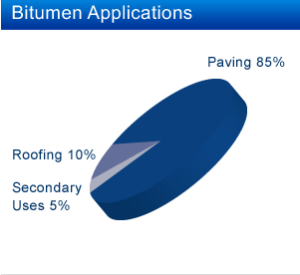Bitumen Heating
Last updated on October 17th, 2023 at 07:07 pm
.Crude oil, unprocessed fossil fuel, is one of the most important natural resources. In its unprocessed form, it does not have many uses but when refined through fractional distillation, it yields a number of products that have a huge variety of uses. Some of the refined fractions of crude oil also exist naturally in their own crude form. One of these refined fractions with its own natural existence is Bitumen.
Bitumen
Bitumen, also commonly yet mistakenly known as Tar or Asphalt, is the residual section, and the heaviest part of the crude oil. It has the highest boiling point and therefore, remains at the bottom of the fractions of the crude oil. It is black in color, sticky and thick. This thickness of the bitumen does not allow it to flow smoothly and thus, makes it a very viscous semi-solid. Its low watt density requires flanged and circulation heaters to be designed with very slow heat-up time to minimize the changes of carbonation.
- As remnants of microscopic organisms, living in the water, heated and pressurized with the earth’s burial; for example:
- Lake Bermudez in Venezuela As infused sandstones or tar sands
- Athabasca tar sands in Canada In hydrothermal veins
- Uinta Basin of Utah, USA
The naturally occurring substance and the refined crude oil product have slightly different properties but they both have a variety of uses across different industries.
Properties and Uses of Bitumen
It is expected that the global demand for bitumen will continually rise at a rate of 3.6% through 2017. Developed countries like the USA were the largest consumers of bitumen but now with a focus on infrastructural development, developing countries in Asia will take over as the growing markets for bitumen.
The wide variety of bitumen properties makes it an excellent material of use in multiple industries, including the construction industry. Here is how and why bitumen is used throughout the globe for a multitude of purposes:
Paving Roads:
Bitumen’s viscous and heavy load resistant properties allow asphalt, used in the construction of roads, to be flexible and durable. The bitumen’s elasticity also helps roads survive the extreme temperature and weather changes.
Roofing:
Bitumen’s ability to withstand structural movements and its waterproof capabilities make it an excellent choice of material to be used for roofing. Around 95% of the global bitumen demand is for paving roads and roofing. The remaining 5% comprises of a number of mentioned and more secondary applications.
Secondary Applications:
Bitumen’s physical properties make it the material of choice for industrial floorings, anti-corrosion pipe coating, paint waterproofing, computer and automotive parts soundproofing and slip layers for bearing piles in electrical insulation and carpet tile backing.
Bitumen Heating for Optimal Performance
Bitumen, in its natural state, is very viscous. It is so thick and sticky that working with it is not only difficult but not very productive either. For optimal performance, bitumen needs to be heated with a high level of precision and care in order to deliver productive results. Here are a few tips that can help with the process of effective bitumen heating.
Avoid Air Exposure:
Hot bitumen should not be exposed to air. If it is necessary to do so, then care must be taken that air exposure is only for a minimal time possible. Air exposure for any more time than the least specified time can lead to bitumen losing its adhesive properties.
Avoid Water Exposure:
Hot bitumen should also not be exposed to water. In case of exposure, the bitumen will start foaming and ruin its essential properties required for the purpose. If somehow, a small quantity of water mixes with hot bitumen, chances are that it will boil violently and spill out of the storage vessels.
Temperature Control:
For optimal performance, the bitumen not only needs to be heated, it needs to be heated at specific maintained temperatures. Each type and grade of bitumen has different temperature recommendations and therefore, each one should be heated accordingly. Bitumen loses its usable properties if cooled below recommended temperatures or oxidized due to overheating. Therefore, the suggested storage temperature should be maintained while transporting it and then mixing it with other components.

Avoid Contamination:
No unnecessary solvents should be added to bitumen. The smallest of contamination, especially by petroleum-based solvents, can alter the physical properties of bitumen and affect its penetration.
Bitumen Tanks
As discussed above, high level of care needs to be taken when storing and heating bitumen. Otherwise, the bitumen loses its properties necessary for the intended purpose, rendering it useless. Usually bitumen tanks are used to store the bitumen.
These tanks are ideal for bitumen storage because of their ideal insulation properties. The tank’s insulation prevents any loss of heat and therefore, helps maintain the temperature for bitumen storage. The bitumen tanks come in a variety of storage capacities, all equipped with supplementary items like thermostats, level indicators and pumps. These bitumen tanks are available in two kinds:
Indirect Heating Bitumen Tanks:
These tanks are equipped with Japanese style thermic oil heaters and automatic pressure jet burners with heating coils. The heaters heat up the thermic oil and pipe it through the tank. The hot thermal fluid heats up the coils, which in turn, heat up the bitumen stored in the tank.
Direct Heating Bitumen Tanks:
The direct heating bitumen tanks use a burner at the end of the tank to heat up fire tubes, running through the tank. These tubes, when heated up, transfer heat to the surrounding bitumen.
Electrical Heat Operated Tanks:
An alternative to the above-mentioned tanks is an electrical heat operated tank, eliminating the use of heating fuels. Whichever tank is chosen for bitumen storage, the heater’s capacity and the heat load should be kept in mind for optimal transfer of heat.
Bitumen is a useful natural resource. Its globally rising demand is a testimony of its valuable properties and their manifold uses. Heating bitumen allows it to perform optimally and therefore, a wide range of insulated tanks, with heating equipment, are specifically designed for its storage.

